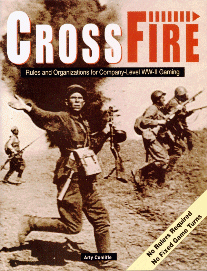By Arty Conliffe

At Historicon in 1995 a friend challenged me to design a historical miniatures wargame that lacked two features present in most rulesets: rulers and fixed game turns. The result is Crossfire – a fast-paced simulation of shifting tactical initiative, where the action unfolds like a film highlighting the critical events of a battle. Crossfire offers the player dozens of critical decisions to make every game, and each one may decide the battle.
Crossfire focuses on company-level, infantry operations by stressing three interrelated features: movement, firepower, and terrain. It assumes the tabletop action is occurring well within the effective ranges of WW-II small arms. By stressing these fundamentals, player commanders in Crossfire are encouraged to use covered terrain routes for troop movements, and establish fire bases that both support their own movements and interdict those of the enemy. Variable troop quality and national command & control differences modify these fundamentals. These conflicting tactical concerns will challenge the best gamers in our hobby. And because these concerns were paramount in the minds of real commanders, I believe Crossfire also succeeds as a simulation, in spite of its abstractions.
We have included a Scenario Generation system which enables gamers to simulate typical combat problems with an infinite number of outcomes; tournaments may be played with this method. One specific scenario has been added showing how to design games based on historical actions. We will be releasing a book of such scenarios in the future.
The average Crossfire game can be played quickly with about 40, 15mm or 20mm figures on a side and perhaps a vehicle or two, and the game works equally well at any figure scale. Rebasing is not required.
I tried to “push the envelope” with this design, and extend the possibilities of traditional miniatures games. Crossfire, therefore, contains many new and unusual game mechanics. You should skim the entire rulebook once before reading it detail.
Questions will be answered providing a SASE is enclosed. On the Internet, there is a web page for Crossfire. SPEARHEAD is my WW-II game for Division-level, miniatures combat for gamers who seek the challenge of larger battles.
Arty Conliffe
More on Crossfire
You can also download the original play testers’ calculations on dice probabilities (PDF) comparing the use of a 6-sided die to a 10-sided one. For a more extensive discussion of probabilities in Crossfire visit Lloydian Aspects.
I’ve been playing war games and attending conventions for 35 years…… I have never had more fun or more satisfying play than with crossfire, even solo …. Thank you, Arty Conliffe and to all those who got these rules and scenarios in our hands.
Stephen Q
Tallahassee, FL